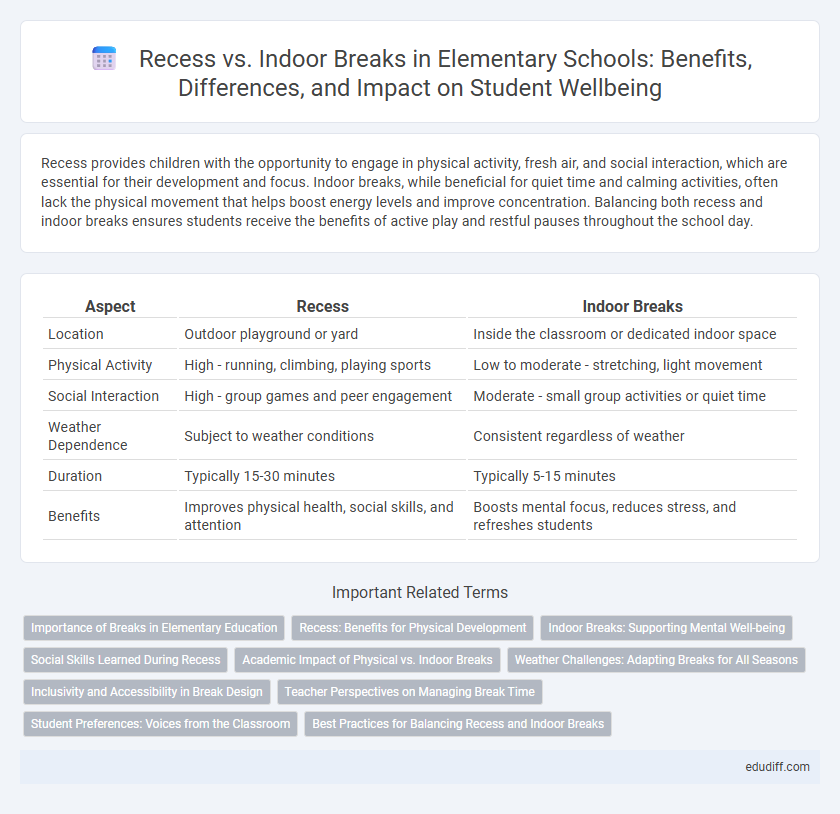Recess provides children with the opportunity to engage in physical activity, fresh air, and social interaction, which are essential for their development and focus. Indoor breaks, while beneficial for quiet time and calming activities, often lack the physical movement that helps boost energy levels and improve concentration. Balancing both recess and indoor breaks ensures students receive the benefits of active play and restful pauses throughout the school day.
Table of Comparison
| Aspect | Recess | Indoor Breaks |
|---|---|---|
| Location | Outdoor playground or yard | Inside the classroom or dedicated indoor space |
| Physical Activity | High - running, climbing, playing sports | Low to moderate - stretching, light movement |
| Social Interaction | High - group games and peer engagement | Moderate - small group activities or quiet time |
| Weather Dependence | Subject to weather conditions | Consistent regardless of weather |
| Duration | Typically 15-30 minutes | Typically 5-15 minutes |
| Benefits | Improves physical health, social skills, and attention | Boosts mental focus, reduces stress, and refreshes students |
Importance of Breaks in Elementary Education
Breaks in elementary education, including recess and indoor breaks, play a crucial role in improving students' cognitive function, focus, and social skills. Recess offers unstructured physical activity that enhances motor skills and promotes healthy peer interaction, while indoor breaks provide opportunities for mental rest and calming activities that aid emotional regulation. Incorporating both types of breaks supports holistic development and increases academic performance in young learners.
Recess: Benefits for Physical Development
Recess plays a crucial role in the physical development of elementary students by promoting active play, which enhances motor skills, coordination, and overall fitness. Outdoor recess encourages running, jumping, and other dynamic movements that boost cardiovascular health and muscle strength. These activities also contribute to improved attention spans and reduced stress levels in children.
Indoor Breaks: Supporting Mental Well-being
Indoor breaks provide a calm and controlled environment that helps reduce stress and anxiety in elementary students. These breaks often include quiet activities such as reading, mindfulness exercises, or puzzles, which support mental well-being and improve focus. Schools that incorporate structured indoor breaks report enhanced student mood and classroom behavior.
Social Skills Learned During Recess
Recess provides children with crucial opportunities to develop social skills such as cooperation, conflict resolution, and empathy through unstructured play with peers. Unlike indoor breaks, which often involve solitary or passive activities, recess encourages active communication and teamwork in diverse social interactions. These experiences help build strong emotional intelligence and prepare students for collaborative environments inside and outside the classroom.
Academic Impact of Physical vs. Indoor Breaks
Physical breaks during recess enhance cognitive function by increasing blood flow and boosting concentration, which improves academic performance in elementary students. Indoor breaks, while providing rest, often lack the physical activity needed to stimulate brain function and may not support memory retention as effectively. Studies show that incorporating active recess leads to better attention spans and higher test scores compared to sedentary indoor breaks.
Weather Challenges: Adapting Breaks for All Seasons
Weather challenges during recess require schools to adapt break times to ensure children's safety and enjoyment across all seasons. Indoor breaks provide a controlled environment during extreme weather conditions like heavy rain, snow, or intense heat, preventing health risks and maximizing student engagement. Implementing flexible schedules and diverse indoor activities helps maintain physical activity levels and social interaction regardless of outdoor weather constraints.
Inclusivity and Accessibility in Break Design
Designing recess and indoor breaks with inclusivity and accessibility ensures all elementary students can participate fully, regardless of physical, sensory, or cognitive abilities. Incorporating adaptive equipment, quiet zones, and varied activity options creates a supportive environment that addresses diverse needs and promotes social interaction. Prioritizing universal design principles in break areas enhances equitable opportunities for rest, play, and socialization among students.
Teacher Perspectives on Managing Break Time
Teachers often find managing recess easier because students can release energy freely outdoors, leading to improved focus in the classroom afterward. Indoor breaks require more structured activities and supervision to keep students engaged and minimize disruptions. Effective break management depends on balancing physical activity opportunities and maintaining classroom order.
Student Preferences: Voices from the Classroom
Students overwhelmingly prefer recess to indoor breaks, citing outdoor play as essential for physical activity and social interaction. Classroom feedback highlights that recess boosts mood and concentration, while indoor breaks often feel less engaging and more restrictive. Research links outdoor recess with improved attention spans and overall well-being in elementary students.
Best Practices for Balancing Recess and Indoor Breaks
Recess and indoor breaks are essential for elementary students' physical health and cognitive development, with recess providing outdoor physical activity and fresh air, while indoor breaks offer calm environments for relaxation and sensory regulation. Best practices include scheduling multiple shorter breaks throughout the day, incorporating movement-based activities during indoor breaks, and ensuring recess time is weather-appropriate and inclusive for all students. Balancing these breaks supports improved attention, social skills, and overall well-being in elementary classrooms.
Recess vs Indoor Breaks Infographic

 edudiff.com
edudiff.com